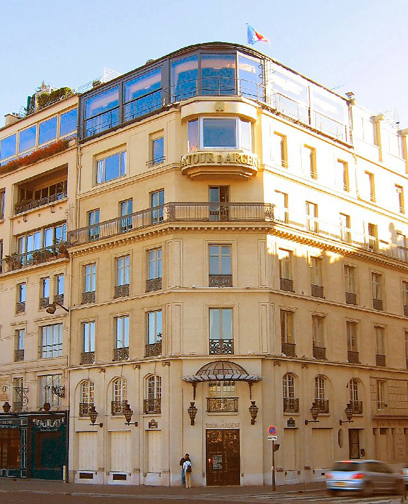I’ve been reading a biography on the Wright Brothers that describes in minute detail the hugely difficult process they went through to create an airplane. One of the side notes that caught my attention was a reference to a Parisian dining experience at the oldest restaurant in France in a letter Orville Wright wrote to his family back in Dayton OH in 1906.
I quote from the book written by David McCullough simply titled The Wright Brothers:
[He was hosted to] an evening at the legendary and highly expensive Tour d’Argent by the Seine on the Left Bank, where a table-side preparation of duck, canard au sang, the main course, performed by the restaurant’s celebrated owner-chef, Frederic Delair, seems to have made a far greater impression on Orville than anything he had seen at the Louvre. Delair worked in a formal tailcoat and with his flowing side whiskers and pince-nez eyeglasses, looked, as Orville would report to Katharine [Orville’s sister], more like a college professor than a chef and had a way of swinging his head as he carved up the duck into small pieces that in itself was worth the full price.
The legs, wings, etc., [Orville continued] are sent to another room where we cannot see them receiving the finishing touches; but the carcass, after most of the meat has been removed is put in a fancy press, and all the juice and marrow extracted. The meat and juices are then placed over the alcohol flame and cooked together. Mr. Frederic basting the meat the entire time. Finally, the duck is served with the enclosed card and folder which gives the serial number of the duck we ate.
I couldn’t help thinking this is a classic example of how you can differentiate your business or product by means of the process by which it is delivered. I’m sure at the time there must have been any number of restaurants that served roast duck but few if any like this one which, incidentally, dates back to the 16th century so it seems to be employing a very sustainable business model!
It’s worth noting a couple of things here.
First, Orville thought the chef’s “way of swinging his head as he carved the duck into small pieces [was] in itself worth the full price” – this had nothing to do with the product, the drama of its delivery created a valuable experience for the guest.
Second, note the reference to the serial number of the duck that was given to Orville. You might be interested to know that is still practiced at the Tour d’Argent and as one diner reported “they [still] give you a certificate for every half duck, mine was already in the 7 figures.”
How many restaurants have you been to that placed such a value on its dishes that it provides a certified serial number? My guess is this gets talked about more than the meal.
Interestingly, when I was in practice I suggested that one of my clients – a kitchen cabinet manufacturer – provide a serial number for each of his installations. I was amazed at how much value his customers placed on this.
The cost was a few cents for the label sticker that was placed on the back of one of the cabinet doors. Compare this with the materials cost for a typical kitchen (from memory) of about 40% of the final price – no one commented on the materials but everyone was interested in the serialized certification and it gave my client an opportunity to talk about his philosophy on quality, his guarantee, and the fact that he retained all the drawings so that if any part of the cabinetry needed to be replaced it was a simple matter.
The message here is the little things really can make a big difference. And because they are “little” they’re often not noticed by your competitors so they offer you a sustainable competitive advantage.

